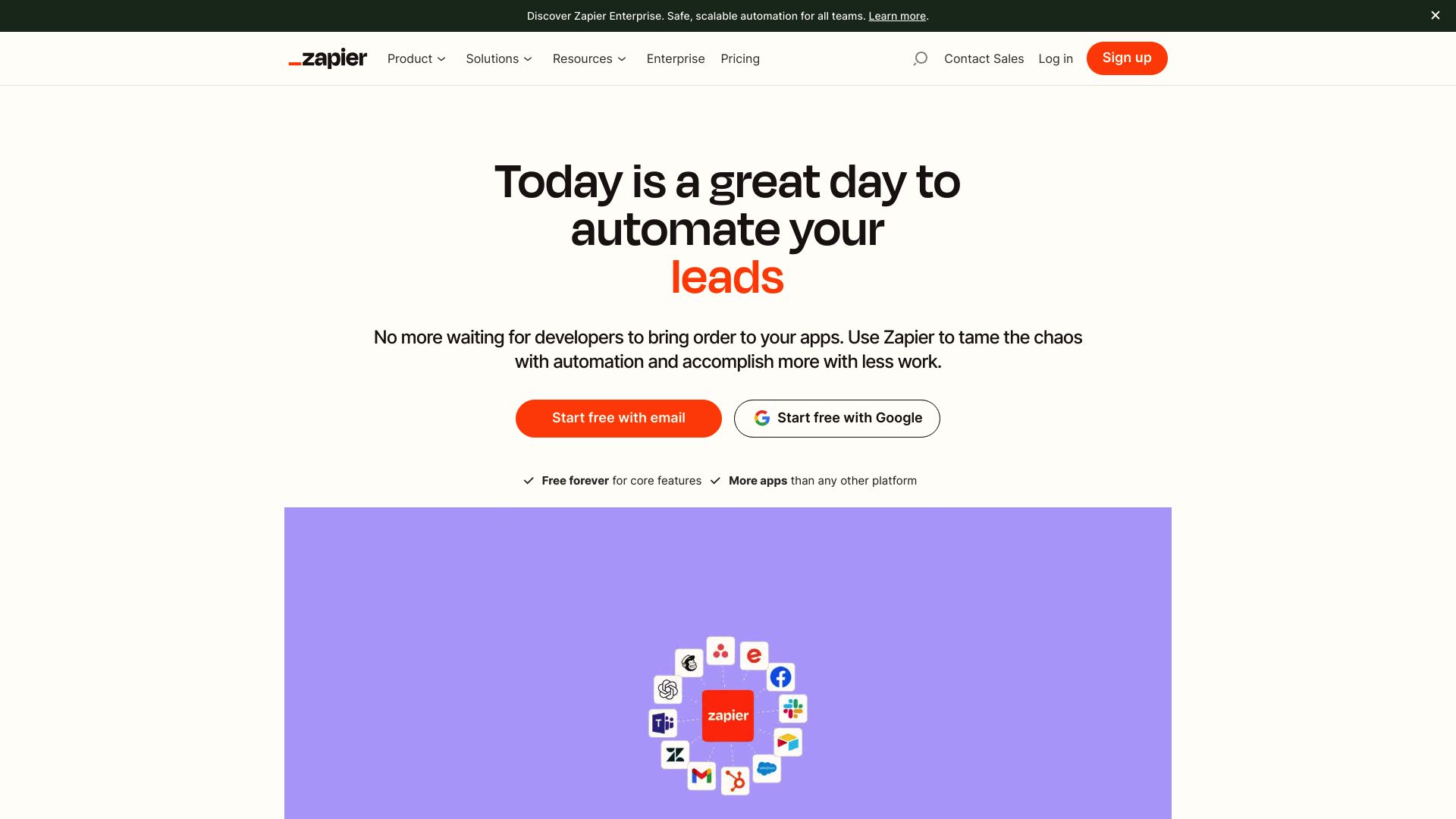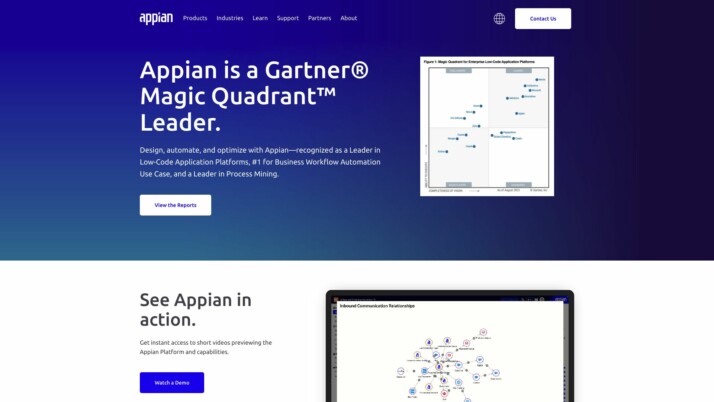Zapier vs. Appian: AI Integration and Workflow Automation Compared
Artificial intelligence is transforming how businesses operate, but leveraging its power effectively remains a challenge. This comparison explores three platforms at the forefront of AI integration and workflow automation: Zapier vs. Appian, and SmythOS. We examine how each tackles the complexities of connecting disparate systems, incorporating AI capabilities, and empowering users to create sophisticated automations. From Zapier’s vast integration ecosystem to Appian’s low-code AI tools and SmythOS’s advanced agent-based approach, we break down the key features, strengths, and limitations of each platform. Whether you’re a developer seeking powerful customization options, a business leader focused on scalability and security, or a non-technical user looking for accessible automation tools, this analysis will guide you in choosing the right solution for your AI and workflow needs.
Zapier Overview
Zapier empowers users to connect and automate workflows across thousands of web applications without coding. The platform’s visual interface enables creating ’Zaps’ — automated workflows that link triggers in one app to actions in another. Zapier’s extensive library of pre-built integrations covers over 6,000 popular business tools and services.


Zapier caters to businesses of all sizes seeking to streamline operations and boost productivity. Its no-code approach allows non-technical users to build complex automations, while developers can leverage Zapier’s CLI for advanced customization. The platform shines in scenarios like automatically adding new leads from web forms to CRM systems or syncing data between project management tools.
Zapier empowers users to connect and automate workflows across thousands of web applications without coding.
Key features include multi-step Zaps for intricate workflows, webhooks for custom integrations, and scheduled triggers for time-based automations. Zapier also offers team collaboration tools, allowing multiple users to create and manage Zaps together. While Zapier excels at connecting disparate systems, it lacks built-in AI capabilities or advanced data processing features found in some specialized automation platforms.
Zapier’s strength lies in its vast ecosystem of integrations and user-friendly interface. However, users requiring deep customization or AI-powered decision-making may find its capabilities limited compared to more specialized tools. Despite this, Zapier’s focus on accessibility and breadth of integrations makes it a go-to solution for businesses looking to quickly implement cross-application automations without extensive technical resources.
Appian Overview
Appian revolutionizes business processes with its low-code AI integration platform. The software empowers organizations to harness artificial intelligence without extensive data science expertise, making advanced technology accessible across industries.
At its core, Appian’s platform excels in streamlining workflow automation by seamlessly incorporating AI capabilities. Users can build custom AI and machine learning models through an intuitive low-code environment, significantly reducing development time and complexity. This approach democratizes AI, enabling a broader range of professionals to create sophisticated, intelligent applications.


Appian Website Screenshot
Appian revolutionizes business processes with its low-code AI integration platform… empowering organizations to harness artificial intelligence without extensive data science expertise.
Appian’s suite of prebuilt AI features stands out, offering document classification, data extraction, email sorting, and generative AI skills. These tools tackle common business challenges, from automating document processing to enhancing communication workflows. The platform’s integration with OpenAI/ChatGPT further expands its natural language processing capabilities, opening up new possibilities for email automation and document management.
Appian prioritizes data security and privacy, a critical concern for enterprises dealing with sensitive information. By ensuring AI models and data remain under the user’s control, Appian addresses key compliance and confidentiality requirements. This approach allows businesses to leverage AI’s power while maintaining strict data governance standards.
The Enterprise Copilot feature exemplifies Appian’s commitment to practical AI applications. By creating knowledge sets from curated documents, users can quickly retrieve accurate information, enhancing decision-making processes and operational efficiency. This tool demonstrates how AI can augment human capabilities in real-world business scenarios.
While Appian offers robust features, users should consider the learning curve associated with maximizing the platform’s potential. The breadth of capabilities may require time and resources to fully implement across an organization. Additionally, as with any AI platform, the quality of outputs depends heavily on the data inputs and model training, necessitating ongoing management and refinement.
Appian’s vision extends beyond mere automation, aiming to make AI an integral part of business operations. By focusing on enhancing human work through intelligent task delegation, Appian positions itself as a catalyst for digital transformation. The platform’s ability to combine AI with comprehensive process management tools offers a powerful solution for businesses seeking to innovate and streamline their operations.
Feature Comparison
Zapier and Appian offer distinct approaches to workflow automation and AI integration. Zapier excels in connecting disparate apps and services through its extensive library of pre-built integrations, allowing users to create automated workflows without coding. Its visual builder and no-code editor make it accessible to non-technical users. However, Zapier lacks built-in AI capabilities and advanced data processing features.
In contrast, Appian provides a low-code platform for integrating AI into business processes. It offers prebuilt AI features like document classification and email sorting, as well as tools to build custom AI models. Appian’s Enterprise Copilot and integration with generative AI services like OpenAI demonstrate more advanced AI capabilities than Zapier. However, Appian may require a steeper learning curve to fully leverage its AI potential.
Both platforms have gaps compared to SmythOS in core AI components and security features. Neither offers hosted AI agents, autonomous agents, or multi-agent collaboration. SmythOS provides these along with features like constrained alignment and extensive deployment options, positioning it as a more comprehensive solution for organizations seeking to deeply integrate AI into their operations.
Feature Comparison Table
| Zapier | Appian | SmythOS | |
|---|---|---|---|
| CORE FEATURES | |||
| AI Agents | ❌ | ✅ | ✅ |
| Hosted Agents (Dev, Production) | ❌ | ❌ | ✅ |
| Memory & Context | ❌ | ✅ | ✅ |
| Autonomous Agents | ❌ | ❌ | ✅ |
| Explainability & Transparency | ❌ | ✅ | ✅ |
| Multimodal | ❌ | ✅ | ✅ |
| Problem-Solving Capabilities | ❌ | ✅ | ✅ |
| Multi-Agent Collaboration | ❌ | ❌ | ✅ |
| Human-AI Interaction | ❌ | ✅ | ✅ |
| Agent Work Scheduler | ❌ | ❌ | ✅ |
| SECURITY | |||
| Constrained Alignment | ❌ | ✅ | ✅ |
| IP Control | ❌ | ✅ | ✅ |
| COMPONENTS | |||
| Foundation AIs | ❌ | ❌ | ✅ |
| Huggingface AIs | ❌ | ❌ | ✅ |
| Zapier APIs | ✅ | ❌ | ✅ |
| Classifiers | ❌ | ✅ | ✅ |
| Logic | ❌ | ✅ | ✅ |
| Data Lakes | ❌ | ✅ | ✅ |
| DEPLOYMENT OPTIONS (EMBODIMENTS) | |||
| Deploy as Site Chat | ❌ | ❌ | ✅ |
| Deploy as Scheduled Agent | ❌ | ❌ | ✅ |
| Deploy as GPT | ❌ | ❌ | ✅ |
| DATA LAKE SUPPORT | |||
| Hosted Vector Database | ❌ | ❌ | ✅ |
| Sitemap Crawler | ❌ | ❌ | ✅ |
| YouTube Transcript Crawler | ❌ | ❌ | ✅ |
| URL Crawler | ❌ | ❌ | ✅ |
| PDF Support | ❌ | ✅ | ✅ |
| Word File Support | ❌ | ✅ | ✅ |
| TXT File Support | ❌ | ✅ | ✅ |
Best Alternative to Zapier and Appian
SmythOS offers a superior alternative to Zapier and Appian for AI-driven automation. Our platform combines the ease of use found in Zapier’s visual interface with Appian’s AI integration capabilities, while surpassing both in key areas.
We provide a comprehensive ecosystem for creating, deploying, and managing AI agents. Unlike Zapier’s limited automation workflows, SmythOS enables the development of sophisticated, autonomous AI agents capable of complex problem-solving. Our drag-and-drop interface simplifies agent creation without sacrificing power or flexibility.
SmythOS enables the development of sophisticated, autonomous AI agents capable of complex problem-solving. Our drag-and-drop interface simplifies agent creation without sacrificing power or flexibility.
While Appian focuses on integrating AI into business processes, SmythOS takes AI capabilities further. We offer multi-agent collaboration, allowing teams of AI agents to work together on complex tasks. This feature, absent in both Zapier and Appian, unlocks new possibilities for intelligent automation across your organization.
SmythOS stands out with its extensive deployment options. Users can embed AI agents as APIs, chatbots, scheduled tasks, or even GPT models. This versatility, combined with our robust security features and scalable infrastructure, makes SmythOS ideal for businesses of all sizes seeking to harness AI’s full potential.
Conclusion
Zapier and Appian offer distinct approaches to workflow automation and AI integration, each with unique strengths. Zapier excels in connecting disparate apps through its vast library of pre-built integrations, making it ideal for businesses seeking quick, no-code automation solutions. Appian, on the other hand, provides a low-code platform for integrating AI into complex business processes, offering advanced features like document classification and custom AI model creation.
While both platforms have their merits, SmythOS emerges as a superior alternative, combining the best of both worlds and pushing the boundaries of AI integration and automation. SmythOS offers a comprehensive suite of features, including hosted AI agents, multi-agent collaboration, and advanced deployment options that neither Zapier nor Appian can match. Its intuitive drag-and-drop interface, coupled with support for over 300,000 integrations, allows for unprecedented flexibility and power in creating AI-driven workflows.
SmythOS stands out with its ability to deploy AI agents across various platforms, from APIs to chatbots, and even as scheduled tasks. This versatility, combined with robust security features and scalability, makes SmythOS an ideal choice for businesses looking to deeply integrate AI into their operations. To experience the future of AI automation and see how SmythOS can transform your workflow, create a free SmythOS account today. With unlimited agents and a 30-day money-back guarantee, you can explore the platform’s capabilities risk-free and join the AI workforce revolution.
Last updated:
Disclaimer: The information presented in this article is for general informational purposes only and is provided as is. While we strive to keep the content up-to-date and accurate, we make no representations or warranties of any kind, express or implied, about the completeness, accuracy, reliability, suitability, or availability of the information contained in this article.
Any reliance you place on such information is strictly at your own risk. We reserve the right to make additions, deletions, or modifications to the contents of this article at any time without prior notice.
In no event will we be liable for any loss or damage including without limitation, indirect or consequential loss or damage, or any loss or damage whatsoever arising from loss of data, profits, or any other loss not specified herein arising out of, or in connection with, the use of this article.
Despite our best efforts, this article may contain oversights, errors, or omissions. If you notice any inaccuracies or have concerns about the content, please report them through our content feedback form. Your input helps us maintain the quality and reliability of our information.
